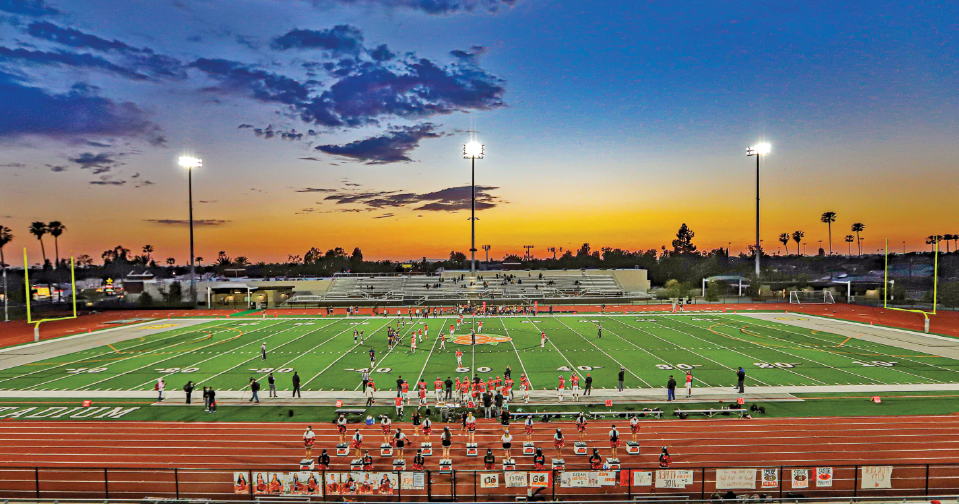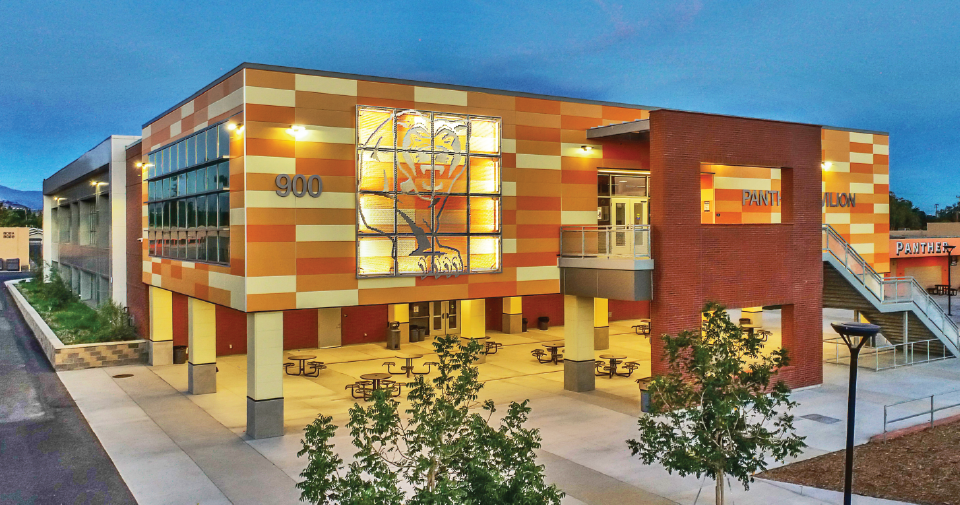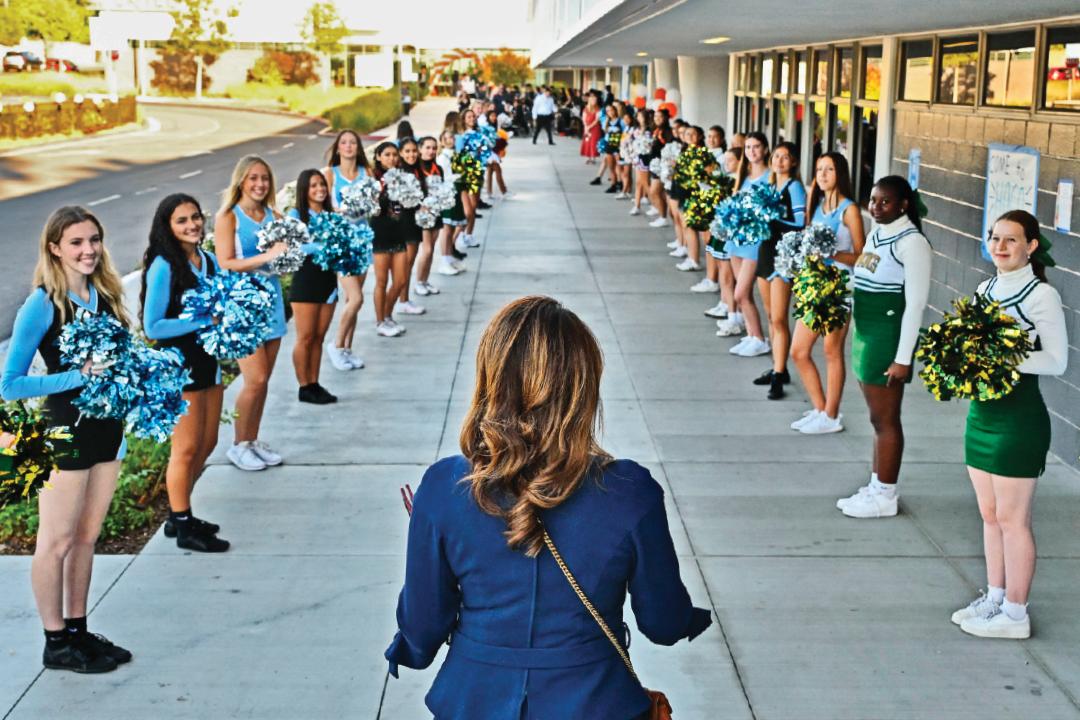
While COVID-19 forced schools across the nation to shift instruction to a virtual format, that didn’t stop Orange Unified School District from working behind the scenes to upgrade multiple facilities in preparation for the return of students.
Two major projects—El Modena High School’s Fred Kelly Stadium and Orange High School’s STEM Complex—rolled out in fall 2020 and have already been used by students and employees. Educators say these facilities will serve students and the community for many years to come.
And with the passage of Measure S in 2016, more schools throughout the district will be getting makeovers, including updated classrooms, science labs and career-training facilities, as well as earthquake retrofitting.

Fred Kelly Stadium
Fred Kelly hurdled his way to gold in the 1912 Summer Olympics in Stockholm, Sweden, bringing hometown pride to his alma maters, Orange High School and the University of Southern California. That pride continues today as the Orange Unified School District celebrates the latest renovation of Fred Kelly Stadium at El Modena High School.
It’s a facility that was first dedicated to Kelly in 1969 and has undergone various renovations, including in 2004 and 2018. The district celebrated the stadium’s reopening virtually in October 2020 and has since hosted more than 30 sporting events, says Scott Harvey, Senior Executive Director of Administrative Services for the district.
“I believe Mr. Kelly would be very impressed with the new stadium,” Harvey says. “Being a champion Olympic hurdler, I think he would appreciate the new synthetic track and seeing his name written on every single hurdle in the stadium.”
Alicia Seevers, Athletic Director for Orange High School, said all four high schools got the chance to play in the stadium last season. But with COVID-19 restrictions, they were unable to use the locker rooms, snack bars or pack the bleachers.
“It was great to get in there and play, but it will be even better to have a fully operational stadium to give them that full experience,” Seevers says.
The district spent $20 million on the project, which includes Americans with Disabilities Act accommodations, as well as food concessions, restroom facilities and expanded seating for visitors. The stadium now holds 3,400 fans on the home side and 1,700 on the visitor’s side—a 25 percent increase.
“Previously, Fred Kelly’s food concessions were limited to the home side of the field, as were the restrooms,” Harvey says. “The new stadium has plenty of restrooms on both sides of the stadium and provides visitors with their own snack bar and ticket booth areas.”
Other features include new lights and a state-of-the-art Bose sound system, a field that can accommodate football, lacrosse and soccer and a new scoreboard that is 17 feet high and 26 feet wide. It is the home field for El Modena, Orange, Villa Park and Canyon high school football programs.
The team rooms include 40 gear lockers, trainer tables, showers and a referee locker room. The press box is now accessible via elevator, and the stadium includes a top deck for coaches and media.
“CIF and other organizations are clamoring to partner with us and use the stadium for higher-profile athletic and community events,” Harvey says.
The district hopes to hold an official opening ceremony during the 2021-2022 school year.

Orange High School STEM Complex
When crews first built Orange High School in the 1950s, the new classrooms, labs and other facilities likely brought excitement to the students and faculty members who used them. But seven decades later, that excitement faded with the challenges of teaching in aging and outdated classrooms.
Christina Churney, a faculty member who heads the chemistry department at Orange High School, previously occupied the sole chemistry lab on campus, having to share her room with other chemistry teachers when they needed to teach experiments requiring gas and plumbing.
“My chemistry classroom had old pipes, old lab benches and a configuration meant for a different time,” she says.
But thanks to Measure S—a $288 million bond measure—the district was able to construct the $27 million STEM Complex, which opened in November 2020.
It’s a two-story building that contains four chemistry and eight science classrooms, one general classroom and two living skills classrooms. The new facility has transformed the way students view the school, says Orange High School Principal Dennis McCuistion.
“They know that high-level learning is going to happen there,” McCuistion says. “It’s really changed our entire campus.”
Classrooms come with stations that can accommodate as many as 40 students. In addition to science instruction, the school will also be able to teach other subjects, such as math, in the complex. The living skills classrooms, containing equipment such as a kitchen and laundry facilities, will be used to instruct students with moderate to severe disabilities.
The complex includes a “Maker Space” for students to innovate and a general space with roll-up doors for easy access to outdoor instruction. It’s a space that will be used for Orange High School’s career pathways, including instruction in CPR, handling patients on gurneys and more, McCuistion says.
“We have some amazing students here at Orange High School and amazing teachers who have done fantastic things with limited space and tools,” McCuistion says. “We’re excited to get these (new) tools into their hands so they can expand opportunities for our students.”
Churney agrees. “Our new building sets the tone for learning,” she says. “We have high expectations for students. Now as students enter their new classrooms, they see that this is a place where learning science happens.”



